How to Position a Gooseneck Hitch in Your Truck Bed
 Gooseneck horse trailers are especially useful for those who want the extra space. However, an improperly placed gooseneck hitch can be bad news. They can be dangerous for towing and even damage your vehicle! Let’s take a look at some of the common issues surrounding this topic.
Gooseneck horse trailers are especially useful for those who want the extra space. However, an improperly placed gooseneck hitch can be bad news. They can be dangerous for towing and even damage your vehicle! Let’s take a look at some of the common issues surrounding this topic.
Why is it Important to Properly Place Your Gooseneck Hitch?
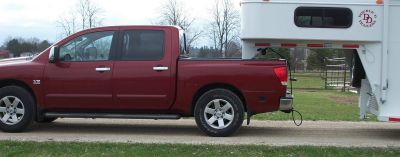 Compared to a bumper pull horse trailer, a properly hitched gooseneck horse trailer is going to delivery more stability and maneuverability during towing. This is because the weight of your trailer is going to be distributed more towards the front and center of the tow vehicle to keep your front truck tires firmly on the ground.
Compared to a bumper pull horse trailer, a properly hitched gooseneck horse trailer is going to delivery more stability and maneuverability during towing. This is because the weight of your trailer is going to be distributed more towards the front and center of the tow vehicle to keep your front truck tires firmly on the ground.
A poorly placed hitch can cause problems when turning. If it is placed too far forward, the front corner of your horse trailer could come in contact with the rear truck cab window possibly breaking the windows.
For this reason, a pick-up truck with a long bed is usually desirable. It is easier for the installer to place the hitch without worrying about any turning radius issues. V-nose trailers are also a better choice because they provide more clearance during turns.
How to Choose the Correct Type of Gooseneck Hitch for Your Tow Vehicle
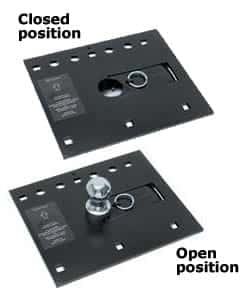
“Our company has installed hundreds of hitches over the years on almost any make/model vehicle you can imagine. There are many different types of gooseneck hitches available and most of those are a ‘bolt-in style.’”
Many of these above-bed or under-bed style hitches are custom fitted to your particular make and model truck. To avoid custom ordering and to speed up service for the customers, Brad decided to offer his clients welded in ‘fold-down’ gooseneck hitches instead.
“The preference that worked for our company was a fold down style hitch manufactured by Draw-Tite, Reece, or Atwood.”
Besides ease of install, fold down style hitches also offer several benefits. As the name implies, the hitch ball can be folded down out of the way when not in use leaving a smooth surface in the bed of your truck. Plus, they offer a bit more flexibility in placement.
Finding the “Sweet Spot” for Hitch Placement
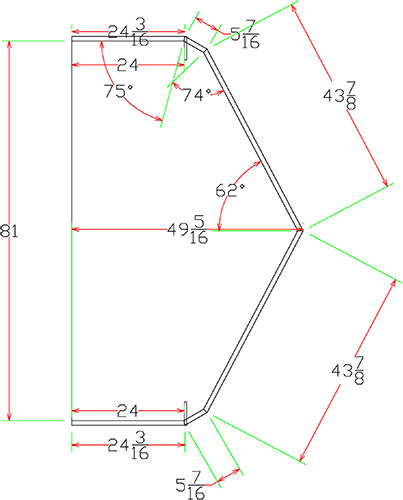
In other words, if you can mount the hitch at least 36" from the back glass, it greatly reduces the chance of you accidentally knocking out the window when making a tight turn.
“When towing a "V" nose gooseneck (like the style we build today standard on our trailers) you could get by with less than 36" on the measurement,” he continued. “Although it would depend on the width of the trailer since wider trailers require more clearance.”
Where Should the Gooseneck Hitch Be Placed in Relation to Rear Axles?
Another thing to consider is the placement of the gooseneck hitch in relation to the rear wheel axles. Proper placement will ensure that the weight of the trailer is correctly distributed on the truck.
We reached out to B&W Turnoverball to get their advice on hitch placement. They replied,
“There are many opinions on this topic, however typically the gooseneck ball will be mounted directly over the center line of the axle or slightly forward. The exception to this is when a hitch manufacture has to work around the structure of the truck. This could cause the ball location to be even further forward on some truck models, in some instances up to 4-inches.”
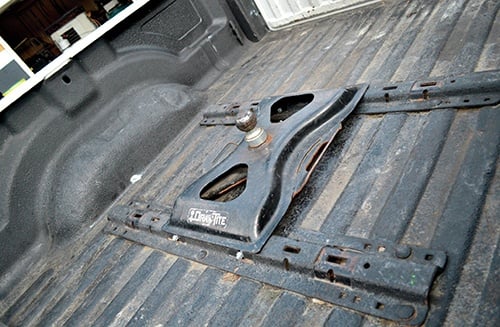
Luckily, if you have your hitch installed at a shop that does weld in style hitches and fabrication, the installer can work around this. They can cut the brace leaving room for the hitch bracing. The hitch can still be placed in the “sweet spot” and the overall bracing of the truck will be perfectly strong.
Brad is confident in this solution. “We would always use a 1 inch thick plate, 4 inches wide and build an "H" Brace to support the system. It's very, very strong and we've had hitches in service since 1995 with some towing farm loads in excess of 20,000 lbs.”
Does a Weld-In Gooseneck Hitch Void a Vehicle Warranty?
This is a common concern for people looking to install a weld-in gooseneck hitch. The answer is actually ‘yes and no.’
“If the shop you use fries your computer board while welding the hitch, the vehicle manufacturer isn't going to cover that,” Brad explained. “Or, if the fabricator is clueless and your chassis ends up cracking or breaking from the installation, the vehicle manufacturer isn't going to cover that.”
He compared this to a local mechanic who changes your oil but forgets to put new oil back in the engine. These careless mistakes won’t be covered.
That being a said, a properly installed weld-in hitch doesn't void the warranty on your engine, transmission, or anything else on your vehicle. “In fact, auto dealerships in the surrounding 100 mile radius of our factory often will bring a new truck to have a weld in hitch installed at our facility. The hitch is included as part of the financing on the new truck.”
The important point is this: Make sure you find a reputable hitch installer who will not mess up the job!
Difference between a Gooseneck Hitch and a Fifth Wheel Hitch
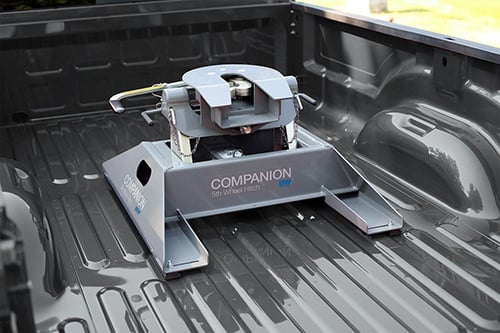
Brad has had a few clients that requested a kingpin coupler on their horse trailer. This is often because they already own a camper with a fifth wheel design and want to use the same configuration for their horse trailer.
“Kingpin couplers are readily available from Bulldog, Superior, and other gooseneck coupler manufacturers so it's an easy switch. In fact, on most ANY gooseneck coupler on a horse trailer, the inner pipe can be removed (which attaches to a gooseneck ball) and a new inner pipe installed with a kingpin.”
Unless you have a special need for a fifth wheel hitch, we wouldn’t recommend a fifth wheel hitch for your horse trailer. The hitch is going to take up a lot of space in your truck bed. It is technically removable, but who wants to go through the hassle of moving such a heavy hitch?
Purchasing a Pre-Owned Vehicle with an Existing Gooseneck Trailer Hitch
If you purchase a pre-owned truck with an existing gooseneck trailer hitch, you should be careful. The hitch may have been properly placed for the previous owner’s trailer, but not for yours. This is especially important if you have a short bed truck or a flat faced gooseneck trailer. Take measurements to make sure you’ll have enough room when turning. If in doubt, consult an expert hitch installer for help.
Can a Gooseneck Horse Trailer Hitch Be Installed at Home?
We do not recommend you try to install your gooseneck trailer hitch at home. “Stick with what you know….get a professional. Many new vehicles will not come equipped with a plug in the bed of the truck, nor a brake control system. More than likely you will need a hitch installed, a plug in the bed, and an automatic brake control system. Not to mention the "auxiliary" circuit on ANY new truck isn't active and a professional installer will activate the circuit for you. The interior lights on most horse trailers operate from the auxiliary circuit.”
Regardless of the style of hitch selected, the key is to find a reputable company that can do the install.
Brad summed it up, “If it's an experienced installer, follow his advice and you will be fine. If a bolt in hitch is an option and fits the "sweet spot", there is much less risk associated with those from an installation perspective.”
Questions:
What questions do you still have about gooseneck hitch placement?

